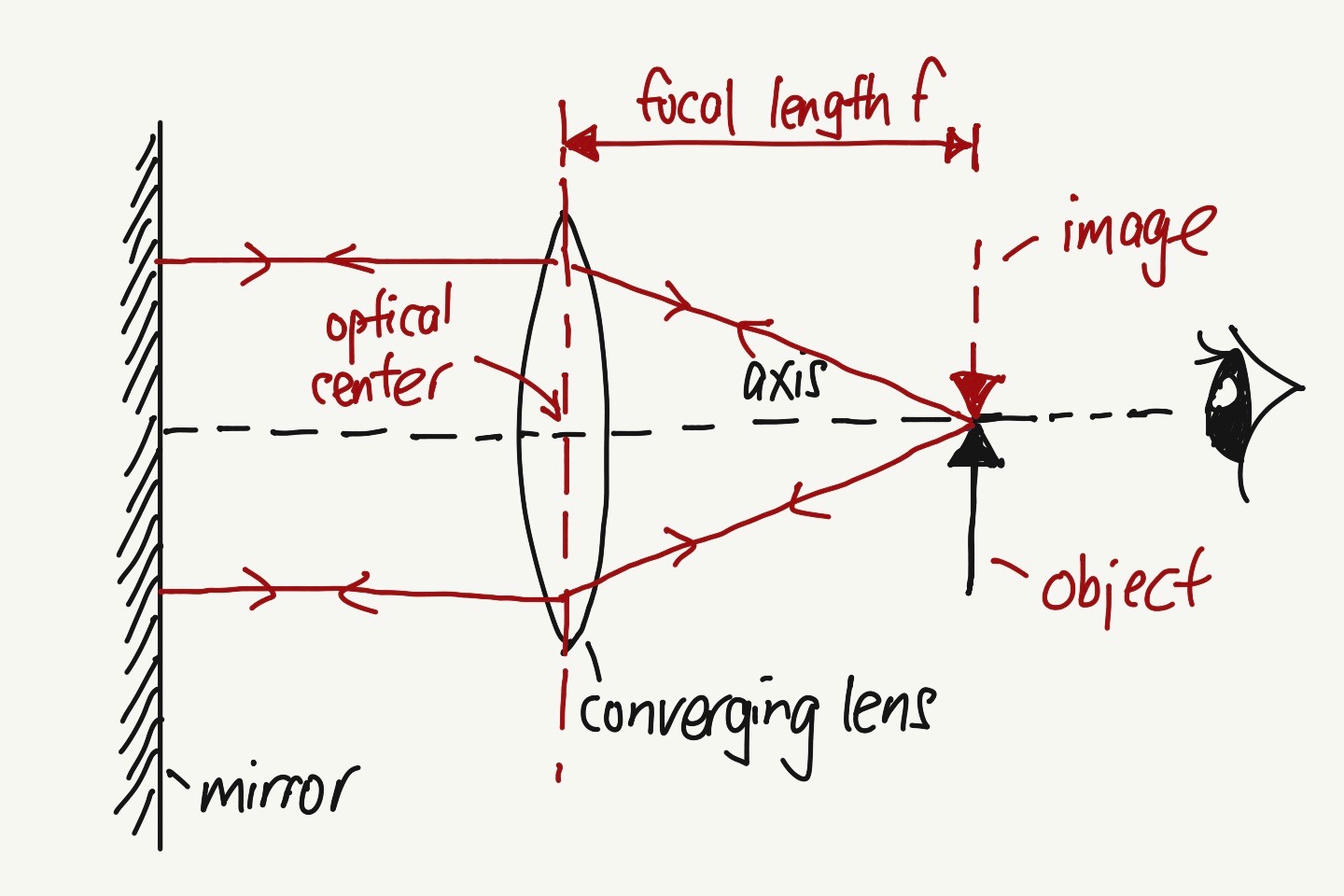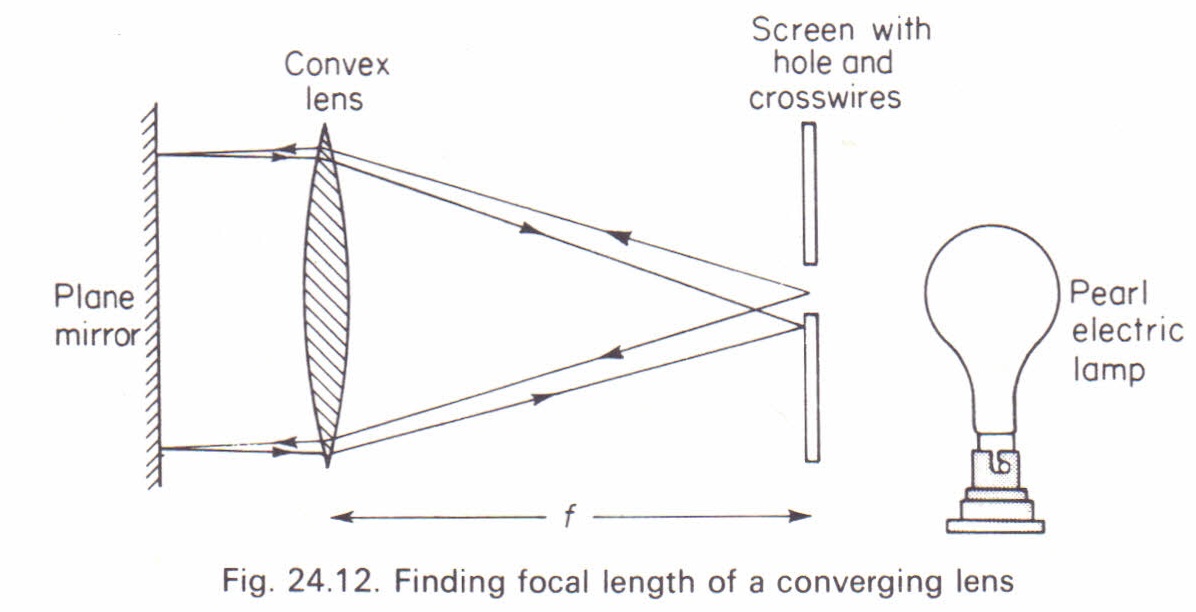To do similar questions, it is important to know the 3 rays which have rules to follow in order to locate the image. Look through the video to learn the concepts and hopefully you can do similar questions in future.




Answer: Option A
Refer to the diagram (below left) which many are familiar. When parallel rays of light which are parallel to the principal axis enter the lens, the rays bend (refraction), come closer and converge to a point on the principal axis called focal point (F). The distance from the optical centre (C) to the focal point (F) is the focal length (f).
But what if the parallel rays of light entering the lens are not parallel to the principal axis but at an angle as shown on the diagram (below right)?
As you can see, the rays refracted and converge to a point P which is along the focal plane (imaginary vertical line through F and is perpendicular to the principal axis). This is similar to L1 in the question. (Refer to the first section of the video simulation below to reinforce your concept)

How about L2 in the question?
Light is reversible so you can also treat the light rays entering from the right of the lens L2. The parallel rays of light in L2 are at an angle but there is no ray through the optical centre C.
Refer to the video below, as you can see, the parallel rays of light will likewise refract and converge to a point, which is along the focal plane too.
Hence the focal point of both lenses L1 and L2 is at F2. So the answer is Option A.
A thin convex lens is placed on a plane mirror and an object pin is then moved along the axis of the lens until an image is seen to coincide with the object pin when viewed from above. What is then the distance between the pin and the lens? (Take f as the focal length of the lens)

A 0.5 f B 1.0 f C 1.5 f D 2.0 f
Answer: Option B
A common mistake is to assume this is the scenario (2nd scenario) where the object is at 2F and the image formed is at 2F, hence the image is the same size as the object, inverted and real. But this is not the case.
Refer to the video tutorial for the explanation.
This set up of the lens with the mirror is using the concept that when parallel light rays (parallel to principal axis) enter the lens, the rays will converge to a point after passing through the lens. This point is called the focal point, F. The distance between F and the optical center of lens is the focal length f. Refer to the diagram below.


When you adjust the object (pin) until both the object and the image coincide even when you move your eye forward or backward perpendicular to the axis, the distance between the optical center and the object (pin) is the focal length f.
At this position, as the rays from the object pass through the lens, due to refraction, the rays converge and becomes parallel to the axis. Due to the mirror, the parallel rays will be reflected back to the lens and then converge to a point that coincides with the object.
Refer to the video on how to get that position.
Before you start the experiment to find the focal length f, there is a fast and easy way to estimate the f. Refer to the video below.
Below is another image of another set-up but with the same concept.

Another similar question below. The answer is Option B
Click here to view the post on a typical lens experiment and things to take note.
Another experiment which involved the same technique. Pins inside and outside the beaker of water
These 2 questions are actually the same. Q23 is from 2010 Pure Physics P1 while Q11 is from 2014 Sci Physics P1. Take a look at these 2 questions. If you are not sure, view the video below for the explanation.

Answer to Q23: Option A

Answer to Q11: Option D
If you do not know how to answer these 2 questions, view this video and also refer to the lens summary below.

Drawing ray diagrams for converging lens come in many forms. But the basic concepts needed are the 3 rays (which have rules to follow) to locate the image. The following ray diagrams for the 4 scenarios must be learned well, together with the respective image characteristics and applications.

With the basic concepts learned, when questions are asked in different ways, you should be able to draw the ray diagrams. Refer to some different ray diagram questions below and their video tutorials.










Click the followings for other lens ray diagram questions. https://evantoh23.wordpress.com/2010/11/09/20101109converging-lens-important-concepts/
https://evantoh23.wordpress.com/2015/08/27/olevel-sp-p1-focal-length-of-lens-using-distant-object/
Which distance is equal to the focal length of a lens?
(A) the distance between a distant object and the image
(B) the distance between the image of a close object and the centre of the lens
(C) the distance between the image of a distant object and the centre of the lens
(D) the distance between two principal foci
Solutions: Option C
Focal length f is the distance between the focal point and the centre of the lens (optical centre).
Note that only when parallel rays of light enter a converging lens, the rays will converge to a point. That point is considered to be focal point F (principal focus). The distance between focal point F and the optical centre is the focal length f. Refer to below.
As none of the options is similar to the above definition, you have to consider that the rays from a distant (far away) object are considered parallel. Hence the sharp image formed on the screen is considered the forcal point F of the lens and the distance between the image and the optical centre is the focal length f.
If it is a close object, the rays entering are not considered parallel. Hence even if the rays converged to a point, that point is NOT focal point F and the distance between this converged point and the optical centre is NOT focal length f.
Click the following posts for other lens concepts:
https://evantoh23.wordpress.com/2017/08/19/different-lens-ray-diagram-questions/
https://evantoh23.wordpress.com/2010/11/09/20101109converging-lens-important-concepts/
A lens forms a blurred image of an object on a screen.
How can the image be made sharp and in focus on the screen?
A) By moving the object away from the lens and screen.
B) By moving the screen away from the lens and object.
C) By using a brighter object at the same position.
D) By using a lens of longer focal length at the same position.
Solutions: Option D (refer to the video on why the image is blurred and how to form a sharp image)
A and B will create a more blurred image.
C – brighter object will not create a shape image.
D – using a lens of longer focal length, when light rays pass through the lens, it will converge to a point further away from the lens. Hence the sharp image will be formed on the school.
Alternatively, you can move the screen nearer to the lens such that the position of the screen is at the intersection of the rays.
Recall that only reflected rays from distant object (object placed far away) are considered parallel. When these parallel light rays pass through the converging lens, they converge to a point, Focal Point (F).
Only then, the distance between the (sharp) image of distant object to the centre of the lens, optical centre (C), is known as focal length (f).
Refer to the diagrams below.


Also refer to another question on lens: http://evantoh.posterous.com/2010/11/09/converging-lens-important-concepts
Which of the following light rays behaves correctly when it passes through the converging lens?

Solutions: Option C
Refer to the following diagrams and recall the basic.
From the diagram above, only when parallel beam of light passes through the converging lens and converge to a point, that point is known as focal point, F. Only then, the distance between F and optical centre, C, is known as the focal length, f.From the diagram above, note that when light ray from object is parallel to principal axis, it will pass through F after passing the converging lens.When light ray passes optical centre, it will pass straight. When light ray passes F and then the converging lens, it will be parallel to the principal axis.
A is wrong as it should be parallel to principal axis after passing through the lens.D is wrong as if after the lens the ray is parallel to principal axis, it must pass through F initially before entering the lens.

The 3 rays shown in the previous diagram are not the only rays from object. In fact, light shines on any point on the object, light is reflected in all direction. We usually concentrate on the 3 rays from drawing of image and its properties (as mentioned above).
For the other rays likewise, all reflected light from that particular point on object will be converged to the same particular point on the image.Hence, B is wrong as did not pass through F before hitting the lens, the light will definitely not pass through F on the other side.Only C is correct.Another important concept, when a parallel beam of light strikes the lens, the light rays will converge to a point which falls along the focal place. Refer to diagram below.